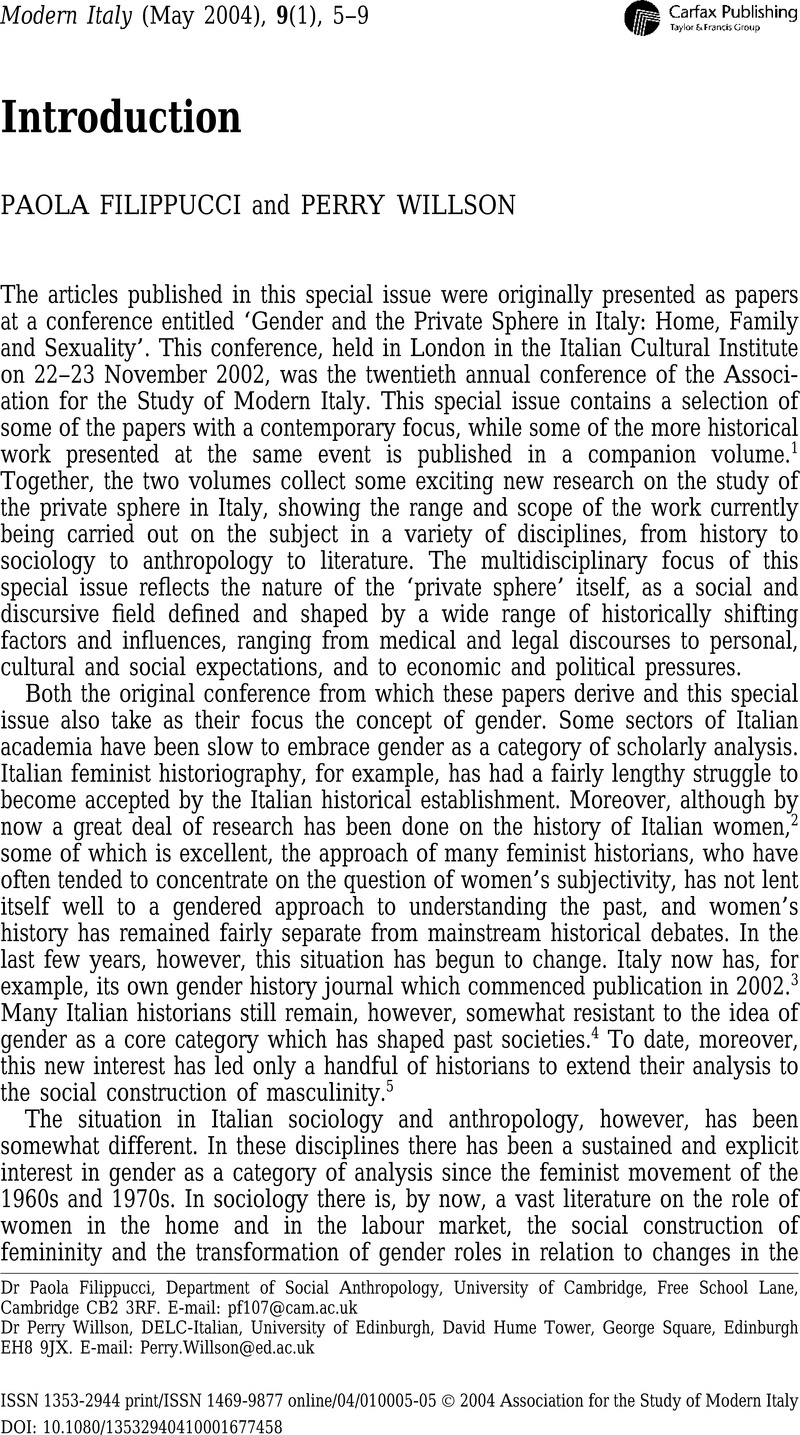No CrossRef data available.
Published online by Cambridge University Press: 07 January 2016

1. Willson, Perry, (ed.), Gender, Family and Sexuality: the Private Sphere in Italy 1860–1945 , Palgrave Macmillan, London, 2004.Google Scholar
2. The bibliography on this topic has grown enormously in the last few years and is far too large to list here. For a useful list of much of the recently published work in this field see the members’ publications section of the website of the Società delle Storiche learned society at http://www.societàdellestoriche.it. Some idea of the range and type of work currently being done in women's and gender history can also be seen from the papers presented at the third annual conference of this organization in Florence in November 2003. (See the website above for the conference programme.) Google Scholar
3. This journal, the journal of the Società delle Storiche (published by Viella in Rome), is entitled Genesis. On its aims and approaches see its first editorial ‘Editoriale’, Genesis. Rivista della Società delle Storiche , 1, 1, 2002, pp. 5–8. See also the review of this first issue by Willson, Perry in the Journal of Modern Italian Studies, 8, 3, 2003, pp. 444–445. On current approaches to women's and gender history in Italy see Doria, Anna Rossi, (ed.), A che punto è la storia delle donne in Italia, Viella, Rome, 2003.Google Scholar
4. On the importance and role of gender in history see, for example, the much-quoted article by Scott, Joan, ‘Gender: a Useful Category of Historical Analysis’, American Historical Review , 91, 5, 1986, pp. 1053–1075. See also Shoemaker, Robert and Vincent, Mary (eds), Gender and History in Western Europe, Arnold, London, 1998.Google Scholar
5. A few pioneering works on this topic have recently been published. See, for example, Arru, Angiolina, (ed.), Pater Familias , Biblink, Rome, 2002; Arru, (ed.), La costruzione dell'identità maschile nell'età moderna e contemporanea, Biblink, Rome, 2001; Bellassai, Sandro and Malatesta, Maria (eds), Genere e mascolinità. Uno sguardo storico, Bulzoni, Rome, 2000.Google Scholar
6. See, for example, Balbo, Laura, Stato di famiglia , Franco Angeli, Milan, 1976; Saraceno, Chiara, Pluralità e mutamento, Franco Angeli, Milan, 1987; Siebert, Renate, ‘È femmina però è bella’: tre generazioni di donne al Sud, Rosenberg and Sellier, Turin, 1991; Colombo, Grazia, Pizzini, Franca and Regalia, Anita, Mettere al mondo: la produzione sociale del parto, Franco Angeli, Milan, 1987.Google Scholar
7. See, for example, Gallini, Clara, Intervista a Maria , Sellerio, Palermo, 1981; Pandolfi, Mariella, Itinerari delle emozioni: corpo e identità femminile nel Lazio Campano, Franco Angeli, Milan, 1991; Galli, Matilde Callari, Il tempo delle donne, Il Mulino, Bologna, 1979; di Cristofaro Longo, Gioia, Codice Madre, Armando, Rome, 1992. On the history of Italian anthropology of Italy see Filippucci, Paola, ‘Anthropological perspectives on culture in Italy’, in Forgacs, David and Lumley, Robert (eds), Italian Cultural Studies: An Introduction, Oxford University Press, Oxford, 1996, pp. 52-71.Google Scholar
8. There is a large body of literature which makes this argument. See, for example, Collier, Jane and Yanagisako, Sylvia (eds), Gender and Kinship. Essays towards a Unified Analysis , Stanford University Press, Stanford, 1987.Google Scholar
9. On Italian demographic trends in the twentieth century see, for example, Treves, Anna, Le nascite e la politica nell'Italia del Novecento , LED, Milan, 2001; Bacci, Massimo Livi, A History of Italian Fertility During the Last Two Centuries, Princeton University Press, Princeton, 1977.Google Scholar
10. See, for example, Gullestad, Marianne and Segalen, Martine (eds), Family and Kinship in Europe , Pinter, London, 1997.Google Scholar